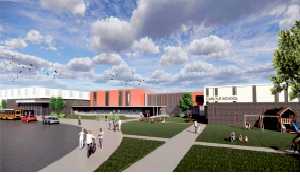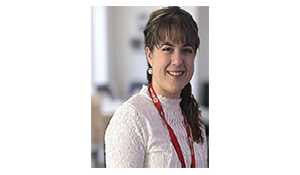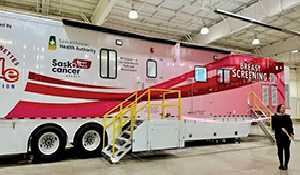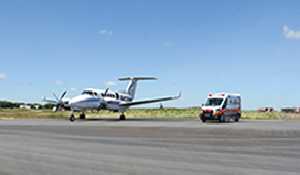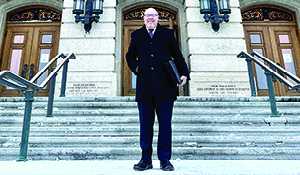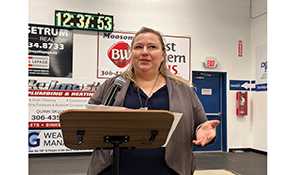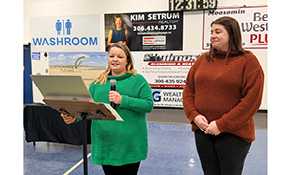CTF Debt Clock kicks off provincial tour
July 21, 2025, 9:24 am
Ryan Kiedrowski, Local Journalism Initiative Reporter

A dismal, rainy Monday morning in front of the Legislative Building in Regina set the tone for launching a cross-Saskatchewan tour about the provincial debt. Gage Haubrich, Prairie Director with the Canadian Taxpayers’ Federation, posed for a photo in front of a large cube truck featuring a running tally on the provincial debt and what the individual taxpayer in Saskatchewan is contributing.
“By the end of this year, the Saskatchewan provincial debt will be $23.5 billion dollars,” he said as we climb into the cab of the truck, escaping the downpour that threatened to ruin his suit jacket. “We’re starting the debt clock here today in Regina at the Leg to make sure that when the Premier looks out his window he sees all the debt that the government has created.”
Haubrich would ultimately not gain an audience with provincial politicians on July 14—only a couple reporters and a few dozen geese that scattered the grounds—but he is planning to swing through Premier Scott Moe’s constituency as part of the truck’s tour.
“We didn’t get a meeting with the Premier on this one, but we will be going through Shellbrook later this week and stopping by the constituency office, taking a couple pictures and maybe making a few videos,” Haubrich said. “Hopefully, he takes that to heart and the taxpayers that live there take it to heart as well.”
According to the climbing debt clock during last Monday’s stop in Regina, the provincial debt is sitting at more than $2.214 billion with the ‘Your Share’ section sitting at more than $17,700. Or, put another way, the debt is rising by approximately $3,000 every minute.
“Around budget season, we make our recommendations and we hope that they listen to them,” said Haubrich of interactions with provincial leaders. “It’s always good to try and get that audience, but the best way to enact that change is to make sure that Saskatchewan taxpayers as a whole have the information that they need. When you get that mass of people who believe that the debt should start going down, as I think a large percentage of Saskatchewan taxpayers do, when they see the facts of how high it’s climbing on the side of this truck, then they’re going to be the ones making the calls to the constituency offices, calling into radio shows and saying, ‘you know, if the Premier wants my vote next time, he’s got to be more fiscally responsible, he’s got to get the debt going down.’ Now that’s what we’re here to do is make sure that taxpayers can get some results.”
From Regina, the truck travelled to Moose Jaw before heading to Saskatoon, Melfort, Humboldt, Prince Albert, Maple Creek, Yorkton, and points in between.
“We’re going to about 10 or so communities across Saskatchewan this week,” Haubrich said. “We’re heading up to Saskatoon tonight, and then heading out to Melfort in the morning and continuing on from there to try and see as many taxpayers as we can and highlight the problem of the increasing provincial debt.”
In a statement from the Ministry of Finance to the World-Spectator, the ministry pointed to the gross domestic product statistics noting how successful the province has been in recent years.
The debt figures quoted by the Taxpayers’ Federation include not only the General Revenue Fund debt, but also Crown Corporations’ debt and government capital debt for financing long-term projects.
Sask has second lowest debt to GDP ratio in Canada
“The Government of Saskatchewan continues to make investments that deliver on what the people of Saskatchewan have said is important to them—affordability, health care, education, community safety and fiscal responsibility,” the Ministry said.
“Saskatchewan maintains the second lowest net debt-to-GDP ratio in Canada and remains a national leader in economic growth, with the province second in the country for real GDP growth in 2024.”
Real GDP in the province grew 3.4 per cent from 2023 to 2024— surpassing the national average increase of 1.6 per cent.
The province’s real GDP also continues to sit at an all-time high of $80.5 billion, which topped the record set in 2023 of $77.9 billion.
There are other areas where Saskatchewan tops the charts, such as private capital investment where the province noted a 17.3 per cent increase last year to $14.7 billion to rank first among all provinces. Trends for 2025 indicate that capital investment could reach $16.2 billion for a 10.1 per cent increase over those numbers of 2024.
Even with those positives, Haubrich feels the government ought to curb spending and make a concerted effort to significantly pay down the debt.
“Saskatchewan is actually near the bottom of the pack (lower debt) in terms of overall debt when it comes to other provinces, and we’re doing all right,” he said of the provincial debt.
“But the problem with that ranking is that it’s not a ‘Best to Worst’ competition, it’s more of a ‘least worst/the most worst’ competition because all across the country, all provinces are racking up debt, sticking taxpayers with a cost.”
Opportunity
to pay down debt Haubrich feels the provincial government ought to tackle the debt and pay it down.
“It’s important to highlight that since Saskatchewan is actually doing all right compared to other provinces, that means we have more of an opportunity to get the debt paid down than other places that are stuck with billions more.
“Saskatchewan is a rich province with a wealth of natural resources,” he continued. “We shouldn’t be having to borrow money to finance our government spending. And we look at that when it comes to good oil years, the government usually gets a bunch of extra money from those high values, and then they spend it all. Then the next year, when oil is down, they have to borrow to make up the difference. Whereas the government should be saving the money when it’s here and not spending it faster than it comes in.”
Currently, Saskatchewan is sixth in terms of total provincial debt with Ontario leading the pack at over $446.2 billion, followed by Quebec at $261.2 billion. In third place is B.C. at $143.8 billion, followed by Alberta at $87.3 billion, and Manitoba rounding out the top five with $34.7 billion in provincial debt.
It is eighth in terms of debt to GDP ratio.
“Every single year, when we get to the Public Accounts, the government likes to spend way more than it said it was going to in the year previous,” Haubrich said. “In 2024, the government blew its budget by almost a billion dollars. If the government had kept that spending in check, they’d have a billion dollars more that they could have used to pay down the debt and provide tax relief.”
Haubrich cautioned that the debt is not going away, nor is it going to improve without government action.
“If the government doesn’t get spending under control and start paying back the debt, it’s going to get worse for taxpayers,” he said. “Right now, interest payments eat up about $878 million of the budget, or $700 per Saskatchewanian. But as the debt keeps increasing, that means more and more of the budget has to be spent on those debt interest payments, and if the government wants to keep spending on other services, there’s only one other place that they can look for more money and that’s in the pockets of taxpayers.”
Haubrich says the visual impact of numbers whizzing by on a giant screen taking up both sides of a cube truck is an impressive visual.
“Every minute, more than $3,000 is added to the provincial debt,” Haubrich said. “That sounds like a lot of money when you hear it, but when you see it—the numbers just flying by you on the side of the truck—it makes people realize that it is such a big problem and the government needs to do something about it.
“That’s why it’s so important to bring this truck to as many places as possible, because when you talk about billions and even millions, it’s hard to comprehend the scale of those numbers sometimes.
“When you see them flying up on the truck and how many zeros there are at the end of those numbers, you realize that this is a big deal and it needs to be paid back before it gets worse and starts costing taxpayers even more.”
For more information the Debt Clock, people can visit taxpayer.com where a petition calling on the provincial government to pay down the debt can also be found.


